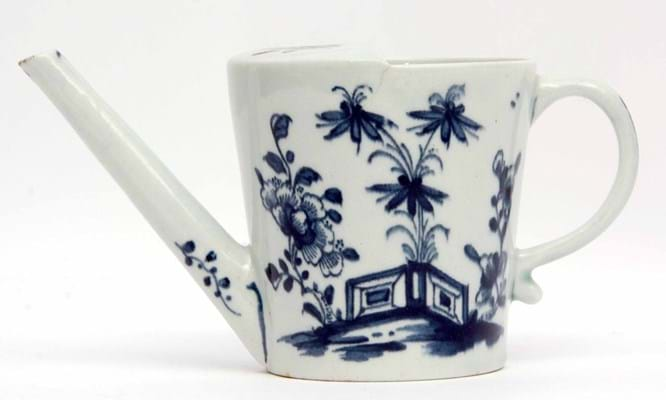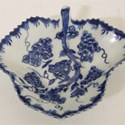It was very much a local concern and local is the best word to describe the scope of factory and its wares, the geographical spread of its original clientele and, by and large, the nature of its collecting base today.
The unsophisticated functionality of Lowestoft products with their inscribed legends and simple floral motifs in blue or, increasingly from the 1770s in polychrome enamels, all combine to impart a naïve charm to this East Anglian porcelain and is a major part of their attraction.
What Do People Collect?
Despite that long production run, Lowestoft's was a small business compared to, say, Worcester, but enough has survived to make it worth collecting and there is not much that is not deemed collectable by someone.
The ceramic body was of soft paste using local clay and bone ash, and the factory was set up by a small group of men including local potter Philip Walker, who formed a company in 1757 named Walker and Co.
The founders aimed to produce useful rather than ornamental wares for local consumption: teabowls and saucers, small creamboats, mugs, jugs, teapots and pickle leaves. At first the decoration was only in underglaze blue and consisted, like so many other early English factories, of Chinese-inspired painted landscapes or simple floral motifs. Although underglaze blue was the staple, from the 1770s polychrome enamelled and blue-printed wares were also produced.
So local was Lowestoft's catchment area that one of the factory's specialities was the production of special commissions made to commemorate a birth, marriage or some other occasion for the surrounding populace, pieces inscribed with the recipient's name, a significant date or place or, more rarely, a view of a local landmark. This means that while Lowestoft porcelain is often unmarked (beyond the occasional painter's mark), a much higher than usual proportion of the pieces are documentary.
The Lowestoft business plan obviously worked, for the factory turned out tablewares and a handful of small animals and other figures for over 40 years.
Lowestoft collecting has always been dominated by East Anglian enthusiasts who will pay handsomely for the best pieces and, as with any long-established market, there have been a number of significant dispersals of these collections. Amongst the best known of these are the Russell Colman collection of the eponymous local mustard-making family sold back in 1948; the Peter Scully collection, sold in 2008 at the specialist Lowestoft auctioneers Russell Sprake, and the Paul Collection formed between the 1930s and 1950s by a local family which sold at Bonhams in 2010.
Many other celebrated multi-factory English porcelain collections have also contained sizeable Lowestoft sections, most notably perhaps that of two writer/collectors, Bernard Watney and Geoffrey Godden, for whom it was an early favourite.
Collectors past and present often built up representative collections of the factory encompassing both the simple floral- or oriental-painted blue and white wares and the rarer inscribed and dated specimens, the scarce animals or the equally desirable miniature or toy pieces. Many of today's enthusiasts have established collections and are now looking to fill gaps with rarities, and the competition for key pieces inevitably raises their value.
With display space at a premium for many collectors, the tiny butter and pickle leaf dishes, often just a couple of inches wide, are also popular, as are toy or miniature wares.
The Market
The cheapest entry-level porcelain for a collector are the modest pieces of routine tableware. It is still possible to buy standard pieces around the £100 mark. These will include small saucers, tea bowls etc with blue oriental-inspired decoration and later pieces with simple formal sprig and swag borders.
Tableware from the so-called Redgrave group, which combine Imari-type underglaze blue with touches of overglaze polychrome enamels, are also at the more affordable end although larger, more complex Redgrave specimens will cost more.
Desirable little pickle leaves and butter boats are a rung up the price scale, as are little cream boats and sparrow-beak jugs. After this, one moves on to teapots and larger jugs and mugs.
At the top of the scale are the inscribed pieces: birth tablets, named and dated mugs or the well -known but not common blue and white and polychrome painted mugs and inkwells famously inscribed A Trifle from Lowestoft (presumably a form of early seaside giftware). Also sought are more decoratively complex pieces with painted and moulded decoration, among them pairs of named tea caddies.
The handful of ornamental figures, usually animals, are also in high demand with collectors, despite their small size and often unsophisticated appearance
The record-priced Lowestoft pieces are painted with those rare local views. In 2010, £24,000 was paid at Bonhams for a very rare flask from the Godden collection painted in underglaze blue with what was probably a local shipbuilding scene to one side, while the auction record for the factory currently stands at £30,000, paid at Russell Sprake in 2011 for a guglet and basin painted in blue with various scenes around the town and coast. Both these pieces were the work of the painter Thomas Allen who joined the factory aged 13 and lived to over 90.
Condition, as always, influences price. So does provenance. Collectors will pay a premium for a piece that featured in the locally famous 1957 Lowestoft Bi-centenary Exhibition held at Ipswich Museum, or for a published piece illustrated in reference works like Geoffrey Godden's monograph, as shown by the prices paid for such items in Bonhams' two auctions of his collection held in 2008 and 2010.
Further Reading
Lowestoft Porcelain by Geoffrey Godden, Antique Collectors' Club, 1985 ISBN 0907462642
Early Lowestoft by Christopher Spencer, Ainsworth and Nelson, 1981 ISBN 0950744603
Lowestoft Porcelain in Norwich Castle Museum by Sheena Smith (Two Vols), Norwich Museum Services, 1985 ISBN MW0019879879


































